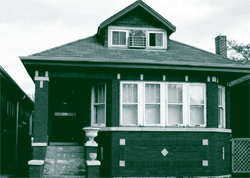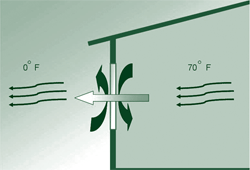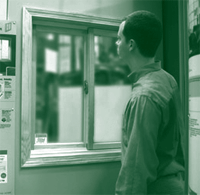May 2009
In this Issue
Local Partnerships Promote Long-Term Prosperity
Storm Windows Can Make a Difference
Land Banks Help Stabilize Properties
The Status of America's Housing
In the next issue of ResearchWorks
Storm Windows Can Make a Difference
Windows provide daylight, ventilation, and solar heating to the inside of our homes, but they are also potential sources of energy loss that can lead to excessive air conditioning and heating costs. The National Association of Home Builders Research Center estimates that 43 percent of American homes have single-pane windows that would benefit from cost-effective improvements. Fortunately, advances in window technology offer far more solutions to energy loss than ever before. As evidence of the choices in window technologies available to satisfy a range of climate demands, we need only note the 34 different generic window types — various glazing materials and designs combined with four frame types — that have been tested by the Center for Sustainable Building Research at the University of Minnesota in each of the four ENERGY STAR® climate zones.1 Researchers evaluated window performance in these tests based on annual energy costs, peak demand, winter and summer thermal comfort, and condensation resistance.

The U.S. Department of Energy (DOE) advises consumers that the best way to improve a home's energy efficiency is with new, energy-efficient windows, but if one is on a tight budget, storm windows are a less expensive option.2 Storm windows are typically mounted on the inside or outside of single-pane windows to improve thermal efficiency. One benefit of a storm window is the creation of dead air space between it and the prime window, which reduces the heat conduction that normally leads to heat loss in winter and to solar heat gain in the summer. A second advantage is a decrease in the air infiltration, or leakage, common to older windows. For these reasons, DOE states that homeowners can reduce heat loss by 25 to 50 percent by installing interior or exterior storm windows.3

In 2002, the Lawrence Berkeley National Laboratory compared the efficiency of different prime/storm window combinations with that of a replacement window treated with a low-emissivity (low-E) coating of metal or metallic oxide to reduce heat loss or gain. This transparent coating not only reduces heat emissivity but also blocks out the ultraviolet light that fades and damages home furnishings. Under simulated conditions, net heat flow comparisons were made based on various prime/storm combinations (prime alone, prime/low-E external storm, prime/ low-E internal storm, prime/regular external storm) with the low-E replacement window. The research team found that the "addition of low-E storm windows to the prime window provided performance very similar to that of the replacement window, and expected differences in performance were only detectable through a sensitive fitting procedure (essentially, a long-term averaging)" (p.14).4
In 2006, HUD's Partnership for Advancing Technology in Housing (PATH), the National Association of Home Builders Research Center, and DOE completed a field investigation under actual conditions.5 This study focused on the difference that low-E storm windows made in reducing residential heating requirements for six Chicago homes that were eligible for the city's low-income weatherization program. These single-family detached homes featured the original single-pane windows typical of construction from the 1920s through the 1960s. The bungalow style homes had brick facades over concrete block exterior walls and no insulation in the walls.
Over the period of one heating season, researchers monitored each home under two conditions — without storm windows and with new storm windows fitted with screens to provide ventilation in spring and summer. Four of the homes with storm window retrofits used windows with a low-E coating, and the other two were fitted with clear glass storm windows. Occupants maintained the same thermostat settings and heating patterns throughout the test, allowing energy use comparisons before and after the storm window installation.
After researchers installed the storm windows, air infiltration measures declined by an average of 15 cubic feet/minute per window. Glass surface temperatures varied significantly between the clear and low-E storm fitted windows. The U-factors, or measures of thermal transmittance, for the single-panel/clear storm window combinations were 0.49 and 0.42, whereas the single-pane/low-E storm combinations had U-factors ranging from 0.36 to 0.30. To put this in context, a lower U-factor means greater efficiency; the prescribed standard for the Northern ENERGY STAR climate zone, in which Chicago is located, is a U-factor of ![]() 0.35.6 In terms of tangible outcomes, reductions were realized in air infiltration, energy usage, and expenditure, as shown below for four of the homes.7
0.35.6 In terms of tangible outcomes, reductions were realized in air infiltration, energy usage, and expenditure, as shown below for four of the homes.7
House |
Storm Window |
Leakage Reduction |
Energy Savings |
Annual Savings |
|---|---|---|---|---|
2 |
low-E |
6.3% |
19% |
$490 |
3 |
clear |
8.2 |
8 |
111 |
4 |
clear |
6.8 |
18 |
317 |
5 |
low-E |
6.4 |
23 |
341 |
Overall, energy use declined by 13 percent in the homes with clear glass storm windows and by 21 percent in those retrofitted with low-E storm windows. The cost per window was estimated at $45. Installed costs for the clear storm windows in Houses 3 and 4 ranged from $1,344 to $2,661; for the two houses installed with low-E storm windows, the cost was $1,738. The average time for Houses 3 and 4 to recoup the costs was projected at 10 years, whereas the projected payback period for Houses 2 and 5 was less than 5 years.
Although the referenced studies were small, they demonstrate that storm windows can offer a cost-saving alternative to new windows. In addition to the information sources provided at the end of this article, readers might also be interested in Windows & Doors, volume 4 of The Rehab Guide published by HUD's Office of Policy Development and Research, available at no cost by visiting www.huduser.gov/publications/destech/rehabgds.html or in print for a nominal fee from HUD USER at 800.245.2691, option 1.

During 2009 and 2010, homeowners who install new storm windows may qualify for a tax credit equal to 30 percent of the materials cost, up to a maximum of $1,500. To be eligible for federal tax credits for energy efficiency, the storm and prime exterior windows combined must meet International Energy Conservation Code standards for the applicable climate zone. Taxpayers must keep a copy of the Manufacturer's Certification Statement that lists classes of exterior windows (single pane, clear glass, double pane, low-E coating, etc.) that a storm window may be combined with to be eligible in a particular climate zone.
See www.energystar.gov/index.cfm?c= products.pr_tax_credits for details. |
|---|
1 Efficient Windows Collaborative/Alliance to Save Energy, "The Efficient Windows Collaborative Multiple Benefits Fact Sheet," September 2009, http://www.efficientwindows.org/factsheets/MultiBenefitsFactsheet.pdf.
2 U.S. Department of Energy, "A Consumer's Guide to Energy Efficiency and Renewable Energy: Storm Windows," December 2008, http://apps1.eere.energy.gov/consumer/your_home/ windows_doors_skylights/index.cfm/mytopic=13490.
3 U.S. Department of Energy, "Energy Savers Tips on Saving Energy & Money at Home," January 2009, www.eere.energy.gov/consumer/tips/windows.html.
4 Joseph H. Klems,"Measured Winter Performance of Storm Windows," Lawrence Berkeley National Laboratory, University of California, 2002, http://repositories.cdlib.org/lbnl/LBNL-51453/.
5 C. Craig Drumheller, Christian Köhler, and Stefanie Minen, "Field Evaluation of Low-E Storm Windows," 2007, www.toolbase.org/PDF/FieldEvaluations/existinghomes_fieldeval_low-e-stormwindows.pdf.
6 The National Fenestration Rating Council (NFRC) operates a uniform national rating system for energy performance of windows, doors, skylights, and similar products. The U-factor is the linchpin of the rating system.
7 Houses 1 and 6 had to be removed from the final energy data analysis.

